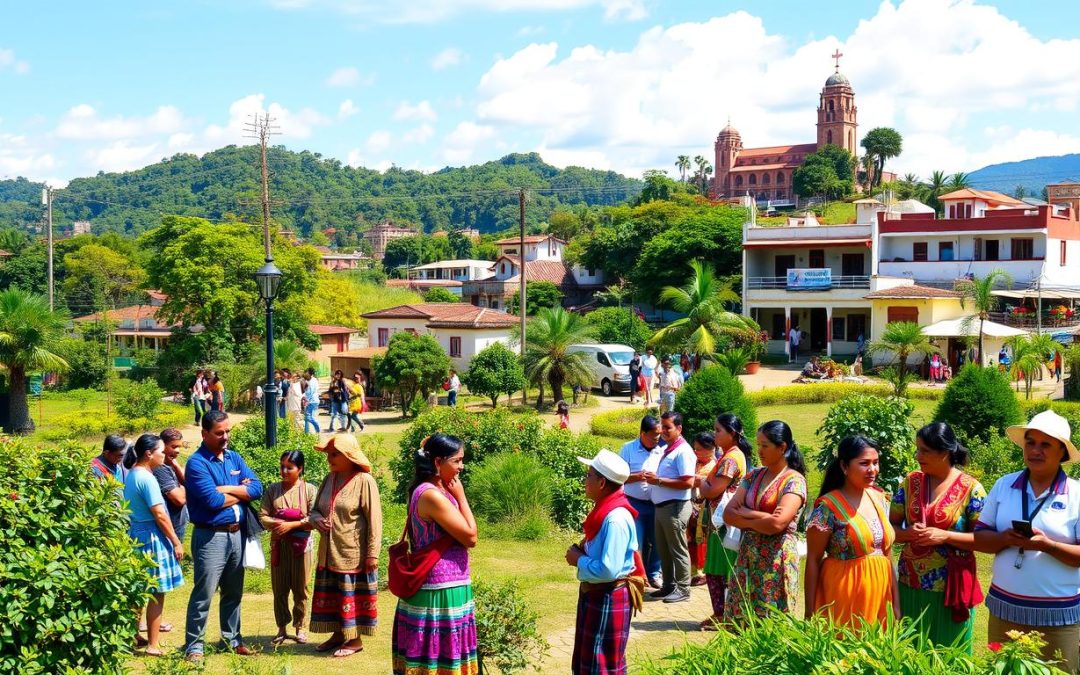Ever wondered how a small Central American nation can have such a rich mix of languages? El Salvador’s language scene is a blend of history, culture, and communication. It’s more than just talking.
Spanish is the main language in El Salvador, as stated in the 1983 Constitution. Almost everyone speaks this lively language. This shows the country’s strong cultural bond.
But El Salvador’s language scene is more than Spanish. It includes indigenous languages, foreign influences, and local dialects. From the rare Nawat language to new foreign language groups, the country’s language world is complex and changing.
Key Takeaways
- Spanish is the official and dominant language in El Salvador
- Indigenous languages like Nawat are critically endangered
- Approximately 7% of the population speaks foreign languages
- English is academically and economically significant
- Salvadoran Sign Language has been officially recognized since 2005
Overview of El Salvador’s Linguistic Landscape
El Salvador’s language heritage is a rich mix of cultures. It’s a multilingual nation, showing how language goes beyond just talking. The country’s language shows its deep history and efforts to keep its culture alive.
The language scene in El Salvador is complex. Spanish is the main language, but the country also values other languages. This is shown in its laws that protect indigenous tongues.
Historical Language Evolution
El Salvador’s language history is long and varied. Indigenous languages like Nawat (Pipil) have coexisted with Spanish. Important events have shaped the country’s language policies and culture.
- Pre-colonial indigenous language networks
- Spanish colonial linguistic influence
- Post-independence language preservation efforts
Current Language Demographics
Recent studies show who speaks what in El Salvador. About 86.3% of people are Mestizo, showing a mix of cultures in language use.
| Language Category | Percentage |
|---|---|
| Spanish (Official) | 98.5% |
| Nawat | 1.2% |
| Other Indigenous Languages | 0.3% |
Constitutional Language Recognition
El Salvador’s constitution values language diversity. Article 62 sees indigenous languages as key to the country’s culture. This shows a forward-thinking approach to language and culture.
“Language is the road map of a culture. It tells you where its people come from and where they are going.” – Rita Mae Brown
Spanish as the Dominant Language
Exploring El Salvador’s language scene shows Spanish as the clear winner. With about 6.5 million native speakers, Spanish is everywhere. You’ll find it in government offices and lively street markets.
The story of Spanish in El Salvador starts with European colonization. It became the official language in 1962. This journey shaped a unique dialect called Caliche.
“Language is the road map of a culture. It tells you where its people come from and where they are going.” – Rita Mae Brown
- Approximately 6.5 million native Spanish speakers
- Official language since 1962
- Influenced by indigenous Nahuatl language
- Distinct pronunciation characteristics
Salvadoran Spanish has its own special touches. People use “vos” for friends and “usted” for formal talks. The way they say some sounds is different, thanks to indigenous languages.
| Language Characteristic | Description |
|---|---|
| Pronoun Usage | Predominantly “vos” in familiar contexts |
| Phonological Feature | Seseo pronunciation |
| Indigenous Influence | Nahuatl language loanwords |
Learning Salvadoran Spanish lets you peek into El Salvador’s rich culture. It shows the long journey of language and culture blending together.
Indigenous Languages of El Salvador
El Salvador’s language history is rich with indigenous tongues that have endured for centuries. These languages show the cultural strength of the country’s native people, even through hard times.
Nawat (Pipil) Language: A Surviving Tradition
The Nahuatl language, known as Nawat, is the most important indigenous tongue in El Salvador. In the early 2000s, UNESCO said Nawat was in severe danger of extinction. At that time, there were fewer than 100 speakers left.
- Approximately 70 elderly people were initially fluent in Nawat
- The Cuna Nahuat language revitalization program has helped preserve the language
- Around 800 children have participated in language preservation efforts
Endangered Indigenous Languages
El Salvador is home to several endangered languages that are struggling to survive:
- Lenca language (Potón): Nearly extinct with only 32 speakers
- Cacaopera language: 24 speakers remain
Extinct Indigenous Languages
The country’s past is marked by a lot of language loss. Before colonization, El Salvador had seven indigenous languages. Now, four are completely gone:
- Poqomam
- Chʼortiʼ
- Xinca (spoken in western Ahuachapán)
- Mangue (spoken in eastern La Unión)
“Language is the road map of a culture. It tells you where its people come from and where they are going.” – Rita Mae Brown
Keeping these indigenous languages alive is key to El Salvador’s cultural and historical identity. Despite the hurdles, efforts to save these languages are ongoing.
Salvadoran Spanish Characteristics
Exploring Spanish in El Salvador reveals a rich cultural heritage. The Salvadoran Spanish dialect has unique traits that make it stand out. It’s different from other Spanish-speaking areas.
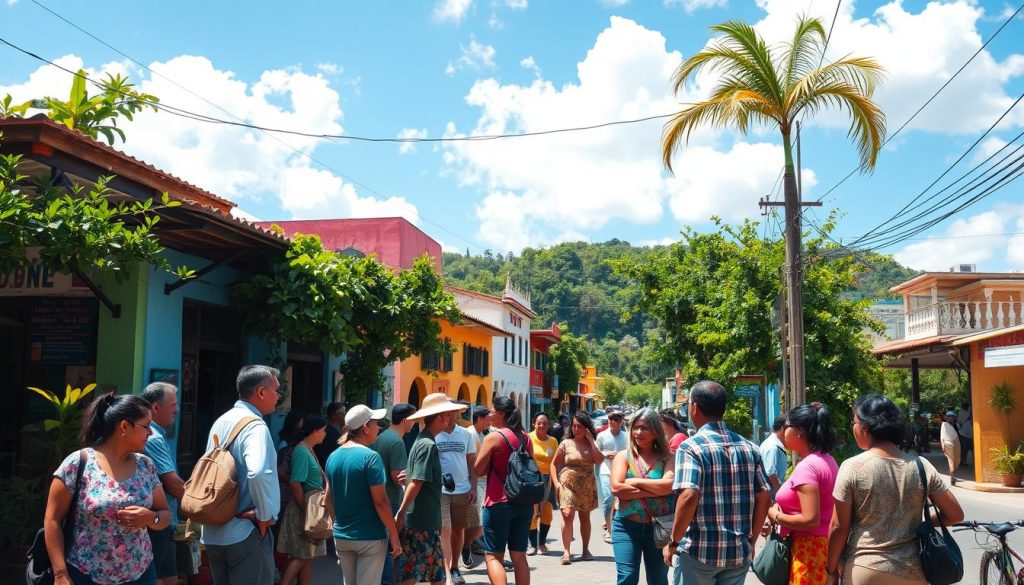
One key feature of Salvadoran Spanish is voseo. This means using “vos” instead of “tú” in everyday talk. This trait links El Salvador to other Central American countries, showing the area’s language diversity.
“Vos querés” instead of “tú quieres” – a hallmark of Salvadoran Spanish pronunciation
Salvadoran Spanish has its own special touches:
- Frequent aspiration of the “s” sound
- Incorporation of indigenous Nahuatl words
- Distinctive local slang called “caliche”
The language shows the country’s rich culture. About 86% of people are mestizo. Nahuatl words like “ayote” (squash) and “cacahuate” (peanut) are common in daily talk.
| Linguistic Feature | Characteristic |
|---|---|
| Pronoun Usage | Voseo (use of “vos”) |
| Pronunciation | Aspiration of “s” sounds |
| Vocabulary | Nahuatl word integration |
Learning Salvadoran Spanish is more than just grammar. It opens a window into the country’s soul. It shows the complex layers of its language and culture.
The Unique Features of Caliche
Explore the lively world of Caliche, a special Spanish variant from El Salvador. It shows the country’s rich language diversity. This informal dialect captures the essence of Salvadoran communication, revealing the cultural nuances of Spanish in this Central American nation.
Caliche is more than a way of speaking. It’s a cultural expression that shows Salvadoran identity. The Spanish language in El Salvador is unique because of this dialect. It’s known for colorful local expressions and a distinct communication style.
Voseo in Daily Communication
Caliche is known for its use of voseo. This sets Salvadoran Spanish apart. Instead of “tú” for “you,” Salvadorans use “vos” in daily talks. This makes conversations feel friendly and intimate.
- Voseo changes verb conjugations
- Creates a more familiar communication style
- Reflects regional linguistic identity
Local Expressions and Dialects
Caliche is full of unique local expressions. These colorful phrases and slang terms show Salvadoran culture. They highlight the country’s rich linguistic diversity.
Regional Variations
While Caliche is common in El Salvador, there are small differences. Urban and rural areas have their own linguistic nuances. Salvadorans are proud of these local differences, adding their own flavor to the dialect.
“Language is the road map of a culture. It tells you where its people come from and where they are going.” – Rita Mae Brown
| Caliche Characteristic | Description |
|---|---|
| Voseo Usage | Predominant second-person pronoun in daily communication |
| Unique Vocabulary | Local slang and expressions not found in standard Spanish |
| Pronunciation | Distinct accent and intonation patterns |
Foreign Languages in Modern El Salvador
El Salvador is not just about Spanish. It’s a place where many languages meet. This makes it a multilingual nation. Foreign languages are becoming more common in schools and work places.
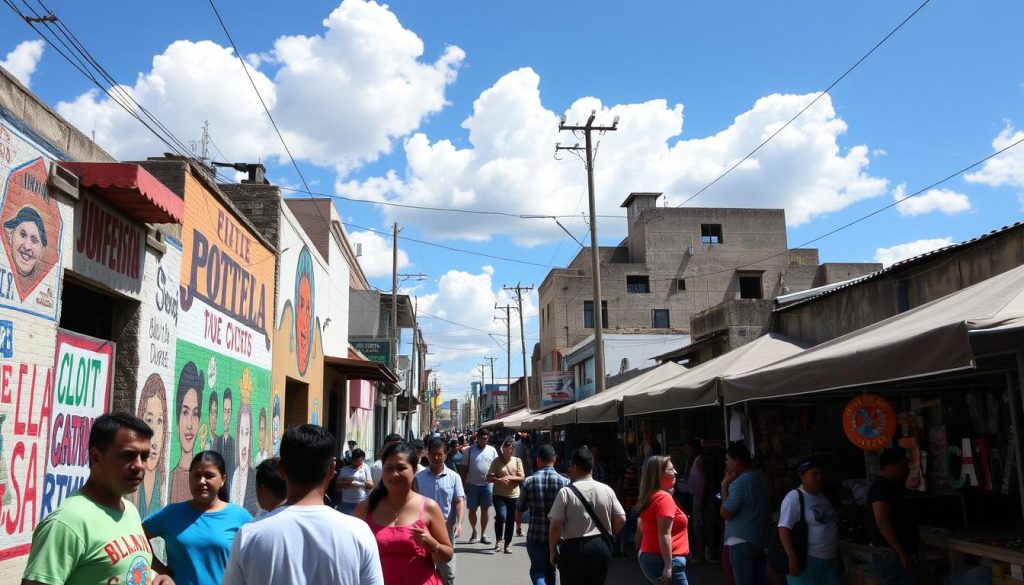
English is the top foreign language, with 3% of people speaking it. It’s key in:
- Business communication
- Tourism sectors
- International trade
- Higher education opportunities
About 24% of Salvadorans want to learn more languages. This shows a growing interest in speaking more languages.
“Language is the roadmap of a culture. It tells you where its people come from and where they are going.” – Rita Mae Brown
El Salvador’s language scene is quite interesting:
| Language | Percentage of Speakers | Primary Usage |
|---|---|---|
| English | 3% | Business, Tourism |
| French | Less than 1% | Academic, Diplomatic |
| Italian | Less than 1% | Cultural Exchange |
The hospitality industry is big on languages, with 40% needing to speak foreign languages. Educational institutions are increasingly recognizing the importance of multilingual education. About 20% of schools offer foreign language courses.
As the world gets smaller, El Salvador is getting more connected through language. This shows its dedication to diversity in culture and work.
Sign Language and Accessibility
El Salvador values linguistic diversity, especially for the deaf community. This is key in language education and making communication inclusive. The country has made big steps in supporting Salvadoran Sign Language (SSL).
Salvadoran Sign Language Development
Since 2005, Salvadoran Sign Language has become crucial for the deaf. With 48,000 to 88,000 deaf people, about 15,000 use SSL mainly.
- Officially recognized in 2005
- Blends elements of American Sign Language (ASL)
- Supports linguistic diversity for deaf individuals
Educational Support Systems
El Salvador has five schools for deaf kids, teaching 458 students. This shows the challenges and chances in language education for the deaf.
| Educational Indicators | Statistics |
|---|---|
| Number of Schools for Deaf Children | 5 |
| Total Students Educated | 458 |
| Recognized SSL Interpreters | 14 |
“Language is not just about communication, but about connection and understanding.” – Deaf Rights Advocate
The government is working to make things better. They want to train more families, healthcare workers, and teachers in sign language. This will help make a place where everyone can communicate freely and with respect.
Language Education System
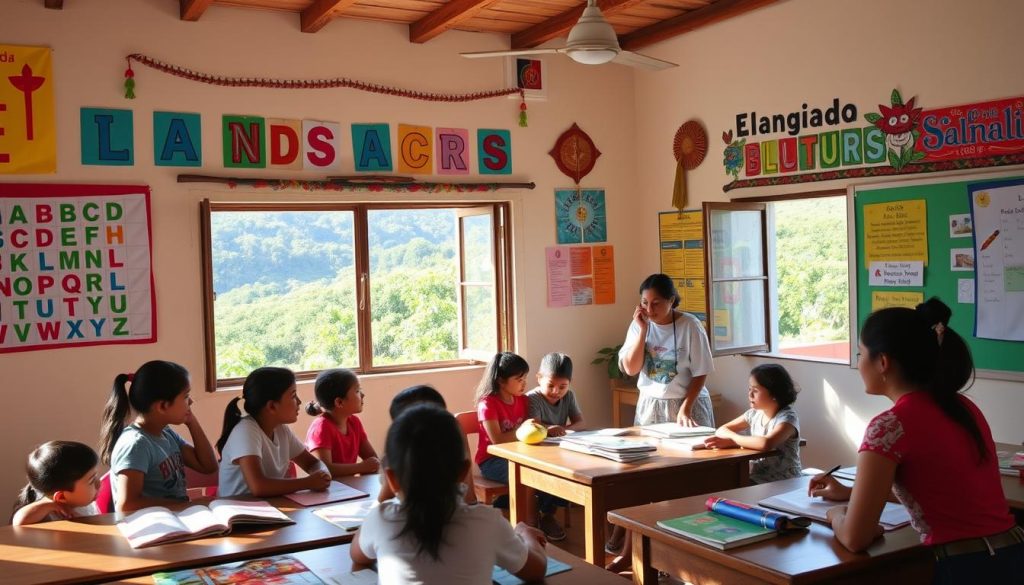
El Salvador’s language education system is complex. It follows a constitutional rule that focuses on Spanish. Yet, it faces issues with access and quality in education.
Understanding language education in El Salvador starts with some key stats:
- Only 82% of children complete 9th grade
- Literacy rates stand at 79% for men and 73% for women
- 56% of Salvadoran students are enrolled in Basic Education
Language policies make Spanish the main teaching language. Public school classrooms typically host more than 40 students. This makes learning hard for many.
“Education is the cornerstone of linguistic preservation and cultural identity” – Salvadoran Educational Ministry
The government spends about 18% of its budget on education. This shows its dedication to language and school infrastructure.
| Education Metric | Percentage |
|---|---|
| Primary Education Achievement | 64.5% |
| Secondary Education Achievement | 65.2% |
| English Proficiency Ranking | 50/111 Countries |
English education is becoming more important. El Salvador ranks 50th in English skills worldwide. This shows a growing need for speaking multiple languages.
Despite the hurdles, El Salvador keeps working on language policies. It aims to improve education and protect cultural heritage.
Impact of Language on Cultural Identity
Language is a strong link between generations and keeps El Salvador’s culture alive. It shows how words hold a nation’s spirit, blending past and present.
El Salvador’s languages tell a story of cultural strength. The mix of Spanish and indigenous languages shows the nation’s deep identity.
Traditional Language Preservation
Keeping traditional languages alive is key to cultural memory. Despite tough challenges, Salvadorans still cherish their linguistic heritage through:
- Maintaining indigenous language archives
- Community-based language learning programs
- Documenting oral histories
“Language is the roadmap of a culture. It tells you where its people come from and where they are going.” – Rita Mae Brown
Modern Cultural Expression
Today, Salvadoran culture uses language in new ways. Young people are making cultural marks by:
- Creating digital content in local dialects
- Developing multimedia storytelling projects
- Promoting indigenous language awareness
| Language Category | Cultural Significance | Preservation Status |
|---|---|---|
| Spanish | Primary Communication | Dominant |
| Nawat (Pipil) | Indigenous Heritage | Endangered |
| Local Dialects | Regional Identity | Evolving |
Understanding these language details shows the deep bond between language and culture in El Salvador.
Language Policies and Government Initiatives
El Salvador’s language policies aim to keep linguistic diversity alive while making Spanish the official language. The government has set up plans to protect and boost linguistic heritage across the country.
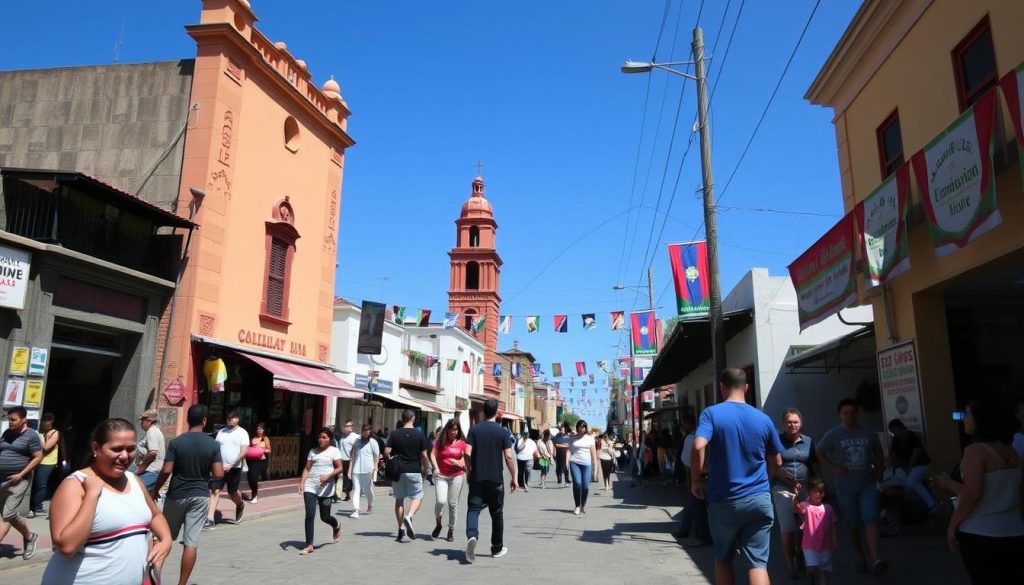
- Constitutional protection of language rights
- Preservation of indigenous linguistic traditions
- Promotion of Spanish as the primary official language
- Support for minority language communities
The government’s language efforts cover several key areas:
- Educational Language Programs: Adding indigenous language education in schools
- Cultural Preservation: Helping to document and bring back native languages
- Official Communication: Making sure information is available in many languages
“Language is the roadmap of a culture. It tells you where its people come from and where they are going.” – Rita Mae Brown
Statistics show the government’s dedication to language diversity:
| Language Category | Percentage |
|---|---|
| Spanish Speakers | 90% |
| Indigenous Language Speakers | 1% |
| Bilingual Population | 9% |
Despite hurdles, El Salvador keeps working on language policies. These policies honor cultural heritage while pushing for national unity in language. The government sees language as a key part of cultural identity.
Future of Languages in El Salvador
El Salvador is moving forward, but it faces big challenges in keeping its languages alive. With about 6.4 million people, the country needs to protect its endangered languages.
Language Preservation Initiatives
The languages of El Salvador are at a turning point. Languages like Pipil are in danger, with UNESCO saying they are critically endangered. By 2014, only about 100 people worldwide still spoke Pipil.
- Cuna Nahuat program launched in 2003
- IRIN pilot project introduced in 2004
- Targeting language education in four schools
- Serving approximately 300 students
Digital Language Integration Strategies
Digital tools are changing how we save languages. Schools and cultural groups are finding new ways to keep indigenous languages alive.
“Language is the roadmap of a culture. It tells you where its people come from and where they are going.” – Rita Mae Brown
Technological Interventions
New ways to document languages are emerging. Digital platforms, online learning, and multimedia archives are helping to save languages. These tools are key for keeping language diversity alive.
| Language | Current Status | Preservation Efforts |
|---|---|---|
| Pipil | Critically Endangered | Digital Documentation Projects |
| Nawat | Extremely Limited Speakers | Online Learning Platforms |
| Lenca | Minimal Speakers | Cultural Heritage Programs |
The future of languages in El Salvador looks bright. Thanks to hard work, new tech, and community support, the country’s rich language heritage can thrive.
Conclusion
Exploring El Salvador’s language diversity shows a rich cultural scene. Spanish is spoken by about 97% of people, making it a vibrant multilingual nation. Despite challenges, indigenous languages like Nahuatl and Pipil keep El Salvador’s cultural spirit alive.
El Salvador’s language journey highlights language’s role beyond just talking. It connects history to today’s life. English and other languages are becoming part of work and school, opening doors to the world.
Looking at El Salvador’s language shows its adaptability. It balances keeping old languages and learning new ones. This shows language is about keeping culture alive, understanding each other, and connecting with heritage.
As El Salvador grows, its language diversity stands strong. It tells a story of resilience and creativity in Spanish, indigenous languages, and global tongues.
The above is subject to change.
Check back often to TRAVEL.COM for the latest travel tips and deals.
Here are some Tours & Sightseeing suggestions that might pique your interests!
